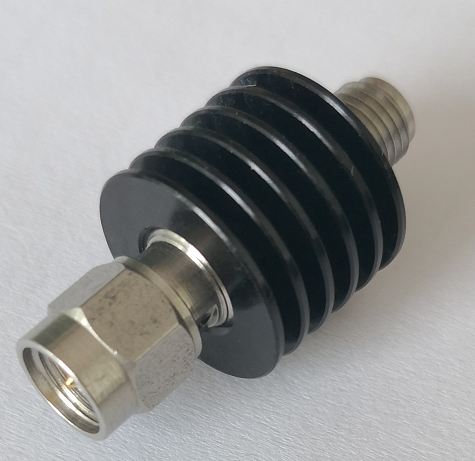Difference Between RF Limiters and Attenuators
By: Peter McNeil

Both RF limiters and Attenuators reduce the power of an RF signal. However, they do so in different ways that are key to understanding their use. These components are often used to protect sensitive RF components and devices.There are also a wide range of RF limiters and attenuators that also operate various ways that may be advantageous for some systems and not others.
RF Limiters
RF limiters are devices that reduce an incoming signal if it’s power level exceeds a threshold of the limiter. It is common to use RF limiters to protect sensitive receivers and signal conditioning circuitry from high incoming signals that would otherwise desensitize the receiver or damage the signal conditioning components. For instance, a low-noise amplifier (LNA) is often a sensitive device where incident power beyond a certain threshold may result in derating or damage to the LNA.
RF limiters may be used anywhere in a signal chain that may experience unintended or unavoidable high signal energy that could damage components or result in undesirable operation. This is the case in portions of the signal chain, such as the input ports of a mixer or gain block amplifier.
PIN diodes are commonly used to implement RF limiters as incident-power controlled, variable resistors. In this implementation the resistance, or attenuation value of the RF limiter is a function of the incident signal power. Hence, a greater incident signal energy will result in higher RF limiter attenuation and a proportionally reduced output signal. RF limiters are typically connectorized with coaxial or waveguide interfaces, though there are surface mount RF limiters.
RF Attenuators
RF Attenuators can be passive or active devices with variable attenuators depending on the design. The basic passive attenuator acts as a resistive element that reduces the incident signal by a certain amount of signal energy. Hence, attenuators are often designated by the decibel (dB) drop the attenuator provides. Basic passive attenuators are both absorptive and dissipative, in that they absorb incoming signal energy and dissipate it as heat, as opposed to reflecting the signal energy or storing the energy. In this way attenuators are often used to reduce reflected signals, such as those from reflective filter typologies and reduce standing waves that would otherwise develop between two reflective ports. These types of attenuators are also typically broadband, depending on if the attenuator is connectorized with coaxial, waveguide, or planar transmission line ports.
There are also passive variable attenuators that enable various attenuation levels depending on a selected setting. Additionally, there are active variable attenuators that exhibit attenuation as a function of a control input. Variable attenuators can be used to control the signal level to keep the signal within a desirable range, or can even be used for modulation in amplitude modulated (AM) or quadrature amplitude modulated (QAM) communications.
射频限制器和衰减器之间的区别
作者:彼得·麦克尼尔
RF 限制器和衰减器都降低了 RF 信号的功率。但是,它们以不同的方式这样做,这对于理解它们的用途至关重要。这些组件通常用于保护敏感的 RF 组件和设备。还有范围广泛的 RF 限制器和衰减器,它们也以各种方式运行,这些方式可能对某些系统有利而不对其他系统有利。
射频限制器
RF 限幅器是在输入信号的功率水平超过限幅器阈值时减少输入信号的设备。通常使用射频限制器来保护敏感的接收器和信号调节电路免受高输入信号的影响,否则会降低接收器的灵敏度或损坏信号调节组件。例如,低噪声放大器 (LNA) 通常是一种敏感设备,其入射功率超过某个阈值可能会导致 LNA 降额或损坏。
RF 限制器可用于信号链中的任何地方,这些地方可能会遇到意外或不可避免的高信号能量,这可能会损坏组件或导致不良操作。信号链的某些部分就是这种情况,例如混频器或增益块放大器的输入端口。
PIN 二极管通常用于将 RF 限制器实现为入射功率控制的可变电阻器。在该实现中,RF 限制器的电阻或衰减值是入射信号功率的函数。因此,更大的入射信号能量将导致更高的 RF 限制器衰减和成比例降低的输出信号。RF 限制器通常与同轴或波导接口连接,尽管有表面贴装 RF 限制器。
射频衰减器
射频衰减器可以是带有可变衰减器的无源或有源设备,具体取决于设计。基本无源衰减器充当电阻元件,通过一定量的信号能量减少入射信号。因此,衰减器通常由衰减器提供的分贝 (dB) 降来指定。基本的无源衰减器既具有吸收性又具有耗散性,因为它们吸收传入的信号能量并将其作为热量散发,而不是反射信号能量或存储能量。通过这种方式,衰减器通常用于减少反射信号,例如来自反射滤波器类型的信号,并减少驻波,否则会在两个反射端口之间产生。这些类型的衰减器通常也是宽带的,具体取决于衰减器是否与同轴、波导、
还有无源可变衰减器,可根据所选设置启用各种衰减级别。此外,还有一些有源可变衰减器,其衰减是控制输入的函数。可变衰减器可用于控制信号电平以将信号保持在所需范围内,甚至可用于调幅 (AM) 或正交调幅 (QAM) 通信中的调制。
